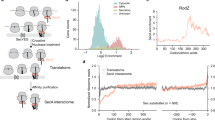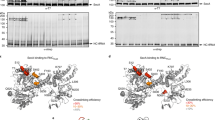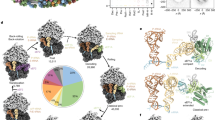Abstract
Identification of the source of energy for protein translocation across biological membranes is important in understanding the mechanism of this process. In eukaryotic cells, the tight coupling between translation and translocation1 and firm attachment of the secreting ribosomes to membranes2, as well as theoretical calculations3, have led to the suggestion that energy derived from protein synthesis is sufficient for protein translocation. On the other hand, in bacterial systems neither the attachment of ribosomes to membrane (other than nascent chains)4 nor tight coupling of translocation to translocation has been observed5–9. Moreover, certain proteins can be translocated across membranes either at the time of, or after, translation7,8,10. The separation of protein translocation from translation has made possible the demonstration that ATP hydrolysis is essential for post-translational protein translocation across bacteiral membranes11–14 and, more recently, also across canine and yeast endoplasmic reticulum membranes15−19. Here we report that certain ATP analogues inhibit co-translational protein translocation at concentrations that do not interfere with protein synthesis, suggesting that ATP is also required for co-translational protein translocation.
This is a preview of subscription content, access via your institution
Access options
Subscribe to this journal
Receive 51 print issues and online access
$199.00 per year
only $3.90 per issue
Buy this article
- Purchase on Springer Link
- Instant access to full article PDF
Prices may be subject to local taxes which are calculated during checkout
Similar content being viewed by others
References
1. Walter, P. & Blobel, G. /. Cell Biol. 91, 557–561 (1981). 2. Sabatini, D. D., Kreibich, G., Morimoto, T. & Adesnik, M. /. Cell Biol. 92, 1–22 (1982). 3. Von Heijne, G. & Blomberg, C. Eur. J. Biochem. 97, 175–181 (1979). 4. Smith, W. P., Tai, P. C. & Davis, B. D. Proc. natn. Acad. Sci. U.S.A. 75, 814–817 (1978). 5. Davis, B. D. & Tai, P. C. Nature 283, 433–437 (1980). 6. Wickner, W. Science 210, 861–868 (1980). 7. Randall, L. L. & Hardy, S. J. S. Microbiol. Rev. 48, 290–298 (1984). 8. Chen, L., Rhoads, R. & Tai, P. C. /. Bact. 161, 973–980 (1985). 9. Muller, M. & Blobel, G. Proc. natn. Acad. Sci. U.S.A. 81, 7421–7425 (1984). 10. Tai, P. C. Curr. Top. Microbiol. Immun. 125, 43–58 (1986). 11. Chen, L. & Tai, P. C. Proc. natn. Acad. Sci. U.S.A. 82, 4384–4388 (1985). 12. Chen, L. & Tai, P. C. /. Bact. 167, 389–392 (1986). 13. Chen, L. & Tai, P. C. J. Bact. 168, 828–832 (1986). 14. Geller, B., Mowa, N. R. & Wickner, W. Proc. natn. Acad. Sci. U.S.A. 83,4219–4222 (1986). 15. Perara, E., Rothman, R. E. & Lingappa, V. R. Science 232, 348–352 (1986). 16. Caulfield, M. P., Duong, L. T. & Rosenblatt, M. /. biol. Chem. 261, 10953–10956 (1986). 17. Waters, M. G. & Blobel, G. J. Cell Biol. 102, 1543–1550 (1986). 18. Rothblatt, J. & Meyer, D. EMBO J. 5, 1031–1036 (1986). 19. Hansen, W., Garcia, P. C. & Walter, P. Cell 45, 397–406 (1986). 20. Grossman, A., Bartlett, S. & Chua, N. H. Nature 285, 625–628 (1980). 21. Eilers, M. & Schatz, G. Nature 322, 228–232 (1986). 22. Randall, L. L. & Hardy, S. J. S. Cell 46, 921–928 (1986). 23. Bakker, E. P. & Randall, L. L. EMBO J. 3, 895–900 (1984).
Author information
Authors and Affiliations
Rights and permissions
About this article
Cite this article
Chen, L., Tai, P. Evidence for the involvement of ATP in co-translational protein translocation. Nature 328, 164–166 (1987). https://doi.org/10.1038/328164a0
Received:
Accepted:
Issue Date:
DOI: https://doi.org/10.1038/328164a0
This article is cited by
-
SecA protein: Autoregulated initiator of secretory precursor protein translocation across theE. coli plasma membrane
Journal of Bioenergetics and Biomembranes (1990)
-
Protein translocationin vitro: Biochemical characterization of genetically defined translocation components
Journal of Bioenergetics and Biomembranes (1990)
-
Phosphatidylglycerol is involved in protein translocation across Escherichia coli inner membranes
Nature (1988)
-
Comparison of the haemolysin secretion protein HlyB from Proteus vulgaris and Escherichia coli; site-directed mutagenesis causing impairment of export function
Molecular and General Genetics MGG (1988)
-
Recent developments in chloroplast protein transport
Photosynthesis Research (1988)
Comments
By submitting a comment you agree to abide by our Terms and Community Guidelines. If you find something abusive or that does not comply with our terms or guidelines please flag it as inappropriate.



